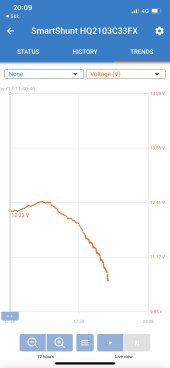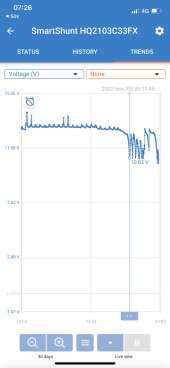Hi,
I have a home built camper van, which we now have been living in full time for one year. The electrical systems consists of various components, a Renogy DC/DC charger, an MPPT from Victron, an inverter from Victron and 3 x Renogy 100ah lithium batteries with self heating.
It is all grounded in the chassi of the van. I recently had a damage repaired after hitting a tree, and suddenly, the batteries started dying on me. I had a look in the app and it seems like the voltage started fluctuating considerably the day the workshop took in in and started working on it (including welding). If I start the car, and the DC/DC charger starts charging, the batteries come back and the shunt shows the charge at 100 %. However, if I run e.g. the diesel heater and some other loads, eventually, the voltage drops to below 10V, and the batteries' under-voltage protection (I assume) switches them off.
Could this potentially be due to poor grounding from the workshop when they were welding the damage? My grounding in the chassi is quite close to the spot where the damage was.
I'll attach two few screenshots from the shunt, one showing the time when it went into the workshop, and the following drops in voltage, and what the voltage looks like when running a few loads over a period of time.
Thanks for any input!
I have a home built camper van, which we now have been living in full time for one year. The electrical systems consists of various components, a Renogy DC/DC charger, an MPPT from Victron, an inverter from Victron and 3 x Renogy 100ah lithium batteries with self heating.
It is all grounded in the chassi of the van. I recently had a damage repaired after hitting a tree, and suddenly, the batteries started dying on me. I had a look in the app and it seems like the voltage started fluctuating considerably the day the workshop took in in and started working on it (including welding). If I start the car, and the DC/DC charger starts charging, the batteries come back and the shunt shows the charge at 100 %. However, if I run e.g. the diesel heater and some other loads, eventually, the voltage drops to below 10V, and the batteries' under-voltage protection (I assume) switches them off.
Could this potentially be due to poor grounding from the workshop when they were welding the damage? My grounding in the chassi is quite close to the spot where the damage was.
I'll attach two few screenshots from the shunt, one showing the time when it went into the workshop, and the following drops in voltage, and what the voltage looks like when running a few loads over a period of time.
Thanks for any input!




